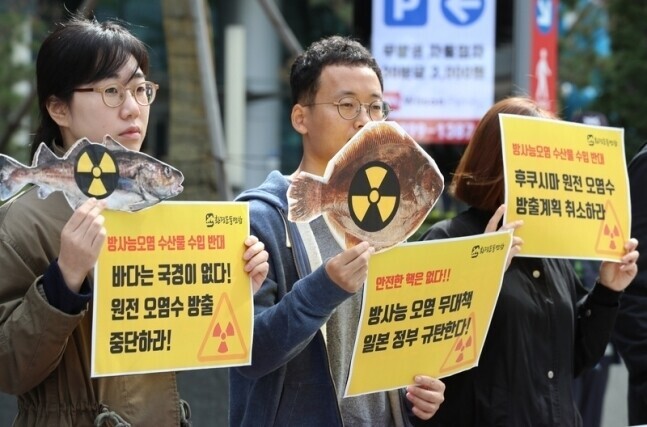hankyoreh
Links to other country sites 다른 나라 사이트 링크
How safe is Fukushima after 2011 nuclear disaster?

Ten years after the Tohoku earthquake on March 11, 2011, safety issues remain a source of controversy in Fukushima, where massive amounts of radioactive material were leaked due to an explosion at the Fukushima Daiichi Nuclear Power Plant.
Many are still worried over whether evacuated residents will be able to return or whether it is safe to eat seafood from the Fukushima region.
Within Fukushima, there are so-called “difficult-to-return zones” where access is strictly controlled due to high levels of radiation in excess of 50 millisieverts (mSv) per year. In other words, these are places that are not fit for human habitation.
They are located across six villages, accounting for roughly 2.5 percent of Fukushima Prefecture’s total area. Due to Fukushima’s large size, 2.5% is just over half the total area of Tokyo’s 23 wards. Residents of these regions would be unable to return even if they wanted to.
To allow residents to return to disaster-affected regions, the Japanese government has undertaken a massive decontamination effort to remove radioactive material. The budget alone has amounted to 4 trillion yen (US$37.9 billion).
Thanks to these decontamination efforts — along with the half-lives of the radioactive substances — the amount of radiation has indeed declined over the last 10 years. Apart from the “difficult-to-return zones,” evacuation orders have been lifted for most areas.
But some have voiced skepticism over the effectiveness of the decontamination. According to a recent report by the international environment group Greenpeace, radioactivity levels have been found to exceed the 0.23 mSv-per-hour long-term target set by the Japanese government in several of the areas where decontamination has been completed.
According to Greenpeace, this is due primarily to the effects of radiocesium.
At eight days, Iodine-131 has a relatively short half-life — the time taken for the quantity of radioactive material to decline by half — and was largely gone from the region within months after the Fukushima disaster.
According to the report by Greenpeace, analysis of samples from mountain forests showed not only cesium but also strontium-90, another carcinogen. Cesium was also detected at levels five times higher than the threshold in Korean rockfish caught in the waters off of Fukushima on Feb. 22 of this year.
Fukushima’s safety is also an important issue for other countries that import farming products and seafood. According to data from Japan’s Ministry of Agriculture, Forestry and Fisheries, 54 countries and regions had restrictions in place at one point on imports of farming products and seafood from Fukushima in the wake of the 2011 earthquake.
But the situation is different for cesium, a Group 1 carcinogen. While Cs-134 has a half-life of roughly two years, Cs-137 has a half-life of 30 years, which means that it is still present and giving off radiation in the soil and buildings.
Another possible recontamination risk in Fukushima is posed by the difficulty of carrying out decontamination in mountain forest areas. At 71%, a large proportion of Fukushima Prefecture’s total area consists of mountain forests.
While that number has significantly declined, 15 countries and regions still have restrictions in place. Nine of them, including the European Union and Indonesia, require proof of testing for radioactive substances. The other six — China, South Korea, Taiwan, Macau, Hong Kong, and the US — have outright barred imports of certain farming, fishing and food products.
At international meetings and elsewhere, Japan has availed itself of every opportunity to demand the overturning of restrictions, insisting that “some countries continue restricting imports of farming products and seafood from Fukushima without any scientific basis.”
By Kim So-youn, staff reporter
Please direct comments or questions to [english@hani.co.kr]

Editorial・opinion
![[Column] Will Seoul’s ties with Moscow really recover on their own? [Column] Will Seoul’s ties with Moscow really recover on their own?](https://flexible.img.hani.co.kr/flexible/normal/500/300/imgdb/original/2024/0513/5917155871573919.jpg) [Column] Will Seoul’s ties with Moscow really recover on their own?
[Column] Will Seoul’s ties with Moscow really recover on their own?![[Column] Samsung’s ‘lost decade’ and Lee Jae-yong’s mismatched chopsticks [Column] Samsung’s ‘lost decade’ and Lee Jae-yong’s mismatched chopsticks](https://flexible.img.hani.co.kr/flexible/normal/500/300/imgdb/original/2024/0512/3017154788490114.jpg) [Column] Samsung’s ‘lost decade’ and Lee Jae-yong’s mismatched chopsticks
[Column] Samsung’s ‘lost decade’ and Lee Jae-yong’s mismatched chopsticks- [Correspondent’s column] The real reason the US is worried about Chinese ‘overcapacity’
- [Editorial] Yoon’s gesture at communication only highlights his reluctance to change
- [Editorial] Perilous stakes of Trump’s rhetoric around US troop pullout from Korea
- [Guest essay] Preventing Korean Peninsula from becoming front line of new cold war
- [Column] The state is back — but is it in business?
- [Column] Life on our Trisolaris
- [Editorial] Penalties for airing allegations against Korea’s first lady endanger free press
- [Editorial] Yoon must halt procurement of SM-3 interceptor missiles
Most viewed articles
- 1Ado over Line stokes anti-Japanese sentiment in Korea, discontent among Naver employees
- 2[Column] Samsung’s ‘lost decade’ and Lee Jae-yong’s mismatched chopsticks
- 3Korean opposition decries Line affair as price of Yoon’s ‘degrading’ diplomacy toward Japan
- 4US has always pulled troops from Korea unilaterally — is Yoon prepared for it to happen again?
- 5Korean auto industry on edge after US hints at ban on Chinese tech in connected cars
- 6[Editorial] Yoon’s gesture at communication only highlights his reluctance to change
- 7[Correspondent’s column] The real reason the US is worried about Chinese ‘overcapacity’
- 8[Column] Will Seoul’s ties with Moscow really recover on their own?
- 9[Photo] Korean students protest US complicity in Israel’s war outside US Embassy
- 101 in 3 S. Korean security experts support nuclear armament, CSIS finds